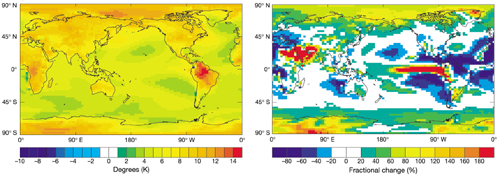 Last month, researchers published
the first results from a worldwide global climate experiment run on tens of
thousands of personal computers across the planet. Their results contain perhaps
the most extreme scenario yet for global warming, with the worst case coming
in at an 11-degree-Celsius increase in Earth's temperature, for a world in which
carbon dioxide levels are doubled.
Last month, researchers published
the first results from a worldwide global climate experiment run on tens of
thousands of personal computers across the planet. Their results contain perhaps
the most extreme scenario yet for global warming, with the worst case coming
in at an 11-degree-Celsius increase in Earth's temperature, for a world in which
carbon dioxide levels are doubled. In response to a doubling of carbon dioxide in a highly sensitive climate model, temperatures (in degrees Celsius) and rainfall (percentages) in the middle of a 45-year timespan increased dramatically in some places. Image copyright David Stainforth; courtesy of Nature.
An online climate experiment built on the blueprint of SETI@home and other such distributed-computing research projects, climateprediction.net has presented researchers with a range of predictions and a way to look at model uncertainty (see Geotimes, April 2004). The "ensemble of ensembles," reported on in the Jan. 27 Nature, took 2,578 simulations for a general circulation model with the atmosphere linked to a mixed-layer ocean. The model is based on the leading model from the Hadley Centre, in Exeter, United Kingdom, which uses two supercomputers to run its climate model for global forecasting. Climateprediction.net, however, took advantage of idle home computer power to run its simulations over a 45-year period to test permutations of the model's variables, starting with different starting conditions and different carbon dioxide levels in the atmosphere.
Each simulation varied six key components at a time, including moisture levels, cloud cover or other parameters. Varying more than one parameter allows the experiment to show how the system might respond as multiple variables interact. The researchers also set the simulations to assess the response to an increase in carbon dioxide. Eventually, the ongoing experiment will test varying 21 parameters "over a wider range of processes and values," they report.
The resulting possible warming so far ranges from just less than 2 degrees Celsius up to 11 degrees Celsius, with the bulk of the results falling around 3.4 degrees of warming. The few models that were more sensitive to changes tended to warm the most, and the researchers note that this is the first time a general circulation model has produced such extreme changes with highly sensitive models.
Most climate scientists agree with the range of warming reported by the IPCC's Third Assessment Report, which found future warming likely to be around 1.5 to 4 degrees Celsius with a doubling of the carbon dioxide levels in the atmosphere, says Richard Alley of Pennsylvania State University. Because of the physics of the system, doubling carbon dioxide generally yields a baseline temperature increase. But, Alley says, the other end of the scale is more open: "It's fairly possible to get a really big number" for temperature changes, so "it's not a surprise." Alley adds that "comparison to past and ongoing changes will help narrow the answer" on future climate scenarios, something this study did not do.
For now, the climateprediction.net team is not able to say how probable the worst-case scenario may be, but they also are unwilling to discount it until it is ruled out by hard data. The project plans a future experiment that unfolds over a longer period, 1950 to 2100, and contains a dynamic ocean in the models.
Naomi Lubick

